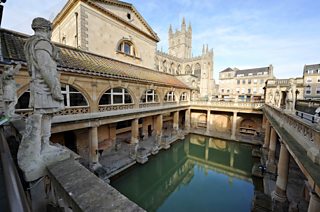Dip into these nine facts about baths
What better accompaniment to a bath than a fascinating podcast… about baths?
Here are some of the things we learned from The Curious History of Your ±«Óãtv, the podcast hosted by domestic historian Ruth Goodman which is bubbling over with facts.
1. Roman baths could be rather large.
In 235 AD, the luxurious Caracalla baths in Rome spanned 27 acres and soared to 130 feet. The complex included a library, an Olympic sized pool, and an underground temple to the Persian god Mithras.

2. … and they were open to all.
Anyone could visit Roman bathhouses, whether they were rich or poor, men or women. Even enslaved people were allowed on special days. The Emperor Hadrian did try to ban mixed-gender bathing, but it wasn’t a rule that many went on to follow.
3. The Romans didn’t invent baths, though.
They have been around for millennia. In 2500 BC, there was the great bath at Mohenjo-daro – one of the largest settlements of the Indus Valley civilisation. Archaeologists believe it was a bathing pool with religious and ritualistic significance.
4. Bathing has long been a spiritual experience.
Ancient Buddhist monks, for example, purified themselves in the communal baths of their monasteries before prayers and meditation. This kind of ritual is still a feature of many religions today.
5. The Middle Ages didn’t smell as bad as you might think.
After the Western Roman Empire fell in 476 AD, the Roman baths fell into disrepair. But that didn’t mean everyone stopped washing. Medieval European villages instead used nearby rivers, lakes, springs, and wells for their water supply. By this point, bathing every day in the Roman style became a luxury for the elite few.
6. Medieval bathhouses did exist.
Around the year 1400 in Southwark, London there were bathhouses that often doubled up as brothels – though not everyone went for that reason. There were medicinal baths to help treat ailments, too. But in 1546, to try to combat the rampant spread of syphilis at the time, King Henry VIII finally ordered the Southwark stews to be closed.
7. The town of Bath has always been a hub for tubs.
Health spas were all the rage in 18th and 19th century Britain. They became fashionable among the wealthy, who flocked to places like Bath for mineral water treatments and to socialise. The town’s Roman baths were rebuilt for this fancy purpose, in the near-classical style.
8. Sharing bathwater was pretty common until at least the 60s.
Especially in areas where indoor plumbing wasn’t readily available. After the second world war, the British economy was devastated – and building the infrastructure to provide hot running water to every home wasn't yet a priority.
9. Baths have healing properties.
A 2018 study reported that regular submersion in water heated to 40 degrees celsius can reduce stress, fatigue and pain, and helps skin condition. And a 2020 study showed that regular baths are associated with a lower incidence of heart disease and stroke.
-
![]()
Short History Of...
Witness history's most incredible moments and remarkable people.
-
![]()
Witness History
History as told by the people who were there.
-
![]()
Sliced Bread
Greg Foot investigates the so-called wonder products making bold claims. Are they the best thing since sliced bread, or marketing BS?
-
![]()
The Science Of Happiness
Learn research-tested strategies for a happier, more meaningful life.






